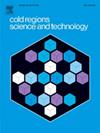Intelligent characterization and robustness quantification of frozen soil strength images using a multi-module fusion strategy
IF 3.8
2区 工程技术
Q1 ENGINEERING, CIVIL
引用次数: 0
Abstract
In frozen wall engineering, traditional detection methods are difficult to implement for real-time monitoring of strength parameters, due to their intermittent nature. This makes it difficult to provide timely warnings and effective responses to potential risks of frozen walls, highlighting the urgent need for a method that can continuously and accurately monitor the strength of frozen walls. An image data-driven intelligent identification method for frozen soil strength based on convolutional neural networks is proposed. By capturing images of cured samples from multiple angles and conducting uniaxial compressive strength tests, the collected strength data were divided into 12 categories, creating an image dataset for deep learning model training. A Resnet-34 deep learning model combined with global attention and downsampling showed excellent performance in comparison with a series of basic models, with an accuracy of 93.3 % and no overfitting. The accuracy of the deep learning model was assessed using adversarial attack and defense strategies, serving as an indicator of robustness. The improved model exhibited better robustness in comparative analyses. Using SHapley Additive exPlanations (SHAP) value analysis, the feature extraction process of the convolutional neural network in recognizing frozen soil strength was investigated and clarified, confirming the model's ability to identify and extract key features in frozen soil images, such as particle size, texture, cracks, and ice crystal distribution patterns. This technology offers a cutting-edge method for real-time tracking of frozen wall conditions and early disaster warnings, significantly enhancing the safety and success rate of construction projects under freezing conditions.
求助全文
约1分钟内获得全文
求助全文
来源期刊

Cold Regions Science and Technology
工程技术-地球科学综合
CiteScore
7.40
自引率
12.20%
发文量
209
审稿时长
4.9 months
期刊介绍:
Cold Regions Science and Technology is an international journal dealing with the science and technical problems of cold environments in both the polar regions and more temperate locations. It includes fundamental aspects of cryospheric sciences which have applications for cold regions problems as well as engineering topics which relate to the cryosphere.
Emphasis is given to applied science with broad coverage of the physical and mechanical aspects of ice (including glaciers and sea ice), snow and snow avalanches, ice-water systems, ice-bonded soils and permafrost.
Relevant aspects of Earth science, materials science, offshore and river ice engineering are also of primary interest. These include icing of ships and structures as well as trafficability in cold environments. Technological advances for cold regions in research, development, and engineering practice are relevant to the journal. Theoretical papers must include a detailed discussion of the potential application of the theory to address cold regions problems. The journal serves a wide range of specialists, providing a medium for interdisciplinary communication and a convenient source of reference.
 求助内容:
求助内容: 应助结果提醒方式:
应助结果提醒方式:


